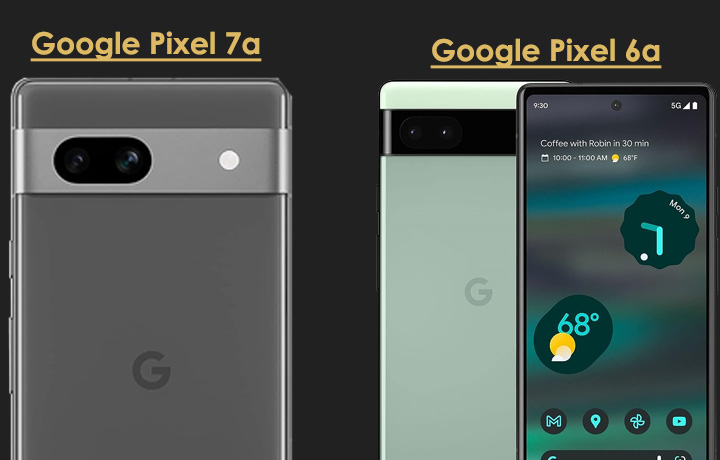Google Pixel 7A vs. Pixel 6A: A Comprehensive Comparison
In the dynamic world of smartphones, where new models are released at a rapid pace, the Google Pixel series has managed to carve out a niche by offering a harmonious blend of features, performance, and affordability.
In this in-depth review, we embark on a detailed exploration of the Google Pixel 7A and the Google Pixel 6A, two devices separated by a generational leap but each holding its unique set of attributes.
These smartphones cater to individuals seeking a harmonious marriage of performance, camera capabilities, and value. We’ll delve into their specifications, design philosophies, performance benchmarks, camera capabilities, and overall user experiences to facilitate an informed decision-making process.
Design Display and Build Quality
Design aesthetics and build quality echo Google’s signature minimalistic approach across both models. Combining glass on the front and plastic on the back, accented by metal edges, results in a durable and visually appealing construction. Although both models resemble each other, the Pixel 7A exudes a slightly more upscale aura.
Notably, stereo audio enriches the media experience, immersing users in vibrant soundscapes. However, the presence of plastic on the back warrants prudent use of protective cases to prevent unsightly scratches and potential damage.
At a cursory glance, the Google Pixel 7A and the Pixel 6A bear a striking resemblance. Their 6.1-inch OLED displays, with identical 1080p resolutions, produce vivid colors and expansive viewing angles. The nuanced difference in bezel widths contributes to a marginal variance in screen-to-body ratios.
However, the Pixel 7A distinguishes itself by featuring a 90Hz refresh rate, compared to the Pixel 6A’s 60Hz. This enhancement elevates user interactions by rendering smoother animations and scrolling, thereby bestowing an added layer of premium feel to the Pixel 7A.
Performance and Hardware
Performance, a critical aspect of smartphone experience, leans in favor of the Google Pixel 7A, powered by its second-generation Google Tensor G2 processor and fortified by 8GB of RAM, as opposed to the Pixel 6A’s first-generation Google Tensor processor and 6GB of RAM.
Though benchmark results might not invariably reflect real-world performance, both devices exhibit fluidity in everyday tasks. Nevertheless, the Pixel 7A’s augmented RAM and enhanced processor potentially contribute to a smoother multitasking environment and better application management, enhancing the overall user journey.
Battery Life and Charging
Battery endurance stands as a paramount consideration for smartphone consumers, and both the Pixel 7A and the 6A present substantial battery capacities. With a slightly larger 4410mAh battery, the Pixel 6A gains a marginal edge over the Pixel 7A’s 4385mAh battery.
This divergence in battery sizes might not be distinctly perceivable in standard usage; however, the Pixel 6A’s moderately larger battery capacity may lend it a stamina advantage.
Both smartphones support 18W fast charging, enabling rapid recharging when necessary. The inclusion of wireless charging in the Pixel 7A, absent in the Pixel 6A, introduces an element of convenience for users who prefer cable-free charging methods.
Camera Capabilities
Renowned for their camera prowess, the Pixel series continues to deliver impressive results through both the Pixel 7A and the 6A. While certain similarities exist, there exist significant distinctions between the two models. The Pixel 7A takes the lead with its 64-megapixel primary camera and a 13-megapixel ultra-wide lens.
In comparison, the Pixel 6A features a 12.2-megapixel main camera and a 12-megapixel ultra-wide shooter. The substantial increase in megapixels within the main camera on the Pixel 7A signifies a concerted effort towards enhancing image quality and detail, whereas the ultra-wide lens on the Pixel 7A offers an expanded field of view.
Both devices perform commendably in the camera department, generating high-quality images, particularly under well-lit conditions. Their front and rear cameras excel in producing crisp and vibrant shots. Portrait mode stands out as a hallmark feature, effortlessly blurring backgrounds and imparting a professional touch to photographs.
- MORE REVIEWS
- XIAOMI 12T REVIEW
- XIAOMI 13 LITE REVIEW
Verdict
In this thorough comparison, we’ve meticulously dissected the attributes of the Google Pixel 7A and the Google Pixel 6A. While sharing commonalities such as screen dimensions and impressive camera capabilities, the Pixel 7A distinguishes itself with superior display quality, more robust performance, and the convenience of wireless charging. Conversely, the Pixel 6A asserts its appeal through affordability, reliable camera performance, and a lower price point.
Choosing between these two models necessitates a careful evaluation of individual priorities. The Pixel 7A appeals to users seeking a more fluid display, enhanced processing power, and wireless charging. On the other hand, the Pixel 6A caters to those who value cost-effectiveness and dependable camera performance. Ultimately, both devices cater to budget-conscious consumers seeking a compelling mid-range smartphone experience, with the choice hinging on personal preferences and priorities.
- Shop On Amazon Using Our Links To Support Us:
- Amazon under $25:
- Amazon best sellers:
- Amazon most gifted:






